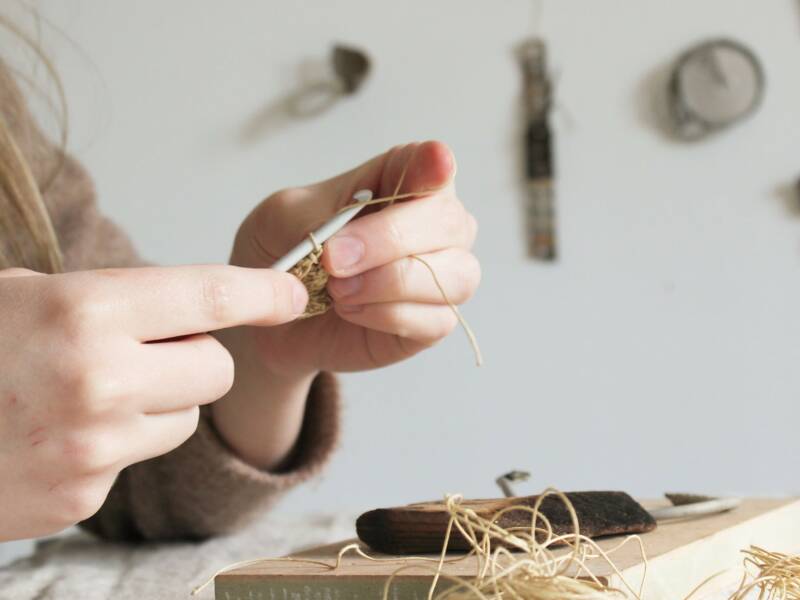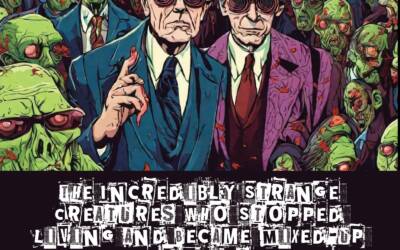

Online Takeover-IN JUXTAPOSITION
By The Black BoxDuring our closure, we had moved our exhibitions online and will feature each monthly artist on our website and social media including an Instagram takeover on our account (@theblackboxbelfast) We are continuing this as well as showcase work again within the venue
Exhibition details here- https://www.blackboxbelfast.com/event/online-exhibition-in-juxtaposition/

What’s your background?
R: I’m Rosie, I graduated from Ulster uni in 2019 with a BA in Jewellery, Silversmithing and Ceramics. I am currently based in England and enjoy exploring narrative, nuance and symbolism through art. I have always been interested in the capacity of art and objects to communicate or open a dialogue when looked at.
S: My name is Sarah Cathers and I’m from County Down. I studied Textile Art at Ulster University and graduated in 2018. I’m a naturally curious being and collector of found oddities. I work with discarded objects, mending and combining materials to curate and assemble small sculptures, creating objects of curiosity or ‘curios’. I like to look at each piece as a tangible record, documenting the environment and people. I display my work in little groups or ‘families’ based on an instinctive response or relationship between materials.
Are there key themes in your work?
R: I think I am still experimenting and discovering how and what I wish to examine through my work. One thing I am sure of, is the presence of thread in my work. It is a material I have utilised from my secondary school days to create with. Identity and spirituality are two themes that have emerged more recently in my work.
S: My work is about preservation, sustainability, memory and connection to a place. I’m inspired by the process of fragmentation, change, cabinets of curiosity, the environment, entomology, museums, biology and archaeology. All subjects I’m fascinated by in my 20’s but didn’t pay much attention to at school! I love museums and I’m fascinated by the way fragments of history are laid out, expressing their value and significance.”
How has your practice developed or changed over time?
R:A major point of development in my work recently has been a move to more textile based work. I have found this medium enabling in developing my own thoughts and drawings.
S:My style has developed quite organically. Before I found my ‘way of working’, I used a chaotic amount of colours that didn’t really work together. I used to make work about a wide variety of different things, based on mostly visual concepts. It wasn’t until my final year that I tapped into the more conceptual ideas that seemed to be evident in every project of mine.
Working with found objects happened very naturally for me, and somewhat accidentally. At the start of my final year I was going through some changes and feeling sentimental about my home and surroundings. From a visual point of view, I started to think about patterns and shapes that were so recognisable and important to me, but were meaningless to anyone else. I began to collect objects, thinking about how they are like little time capsules, visual records, a form of documentation.
I had a very memorable tutorial with my lecturer, Hazel, where I laid everything out, struggling to articulate my thoughts and not knowing whether the objects were relevant. Fortunately, she encouraged me to go with it, experiment a lot, and see what happened. I started playing with them, using threads to wrap and combine them, unsure of what I was doing or working towards. A few weeks later Hazel suggested I buy a drill, and I fell in love with the process.. and the rest is history! I eventually realised that I love earthy colours, natural materials like wood and linen, and lots of texture! I’m all about the neutrals and I love to mix old with new.

What work or processes do you most enjoying doing?
R: I have been enjoying creating experimental work in timed conditions. For example, giving myself ten minutes to create a ring out of plastic from a milk bottle and thread. I have been finding working this way invigorating.
S: My process is a bit messy and very fluid. My desk is usually full of objects, materials, threads, to-do lists, and there’s usually a forgotten cup of tea or bar of chocolate in there too! I find it much easier to work when I have a lot of choice in front of me, the work flows more naturally. I generally take notions for a certain material, colour, or process, which can change from day to day. This means that my work naturally evolves into little collections. Work that was made on the same day tends to look and feel similar, almost like a family resemblance. I enjoy it all, but my favourite part of my practice is definitely installing the work.
I love the hands-on, DIY, tactical, problem-solving, working up a ladder with a hammer and nails element of it.
I love to curate groups of objects, giving them a permanent home either in a frame or on the wall.
I love working on the wall and experimenting with depth, placement, light, and different shadows created when hanging the work on a fine pin.
I love seeing weeks and months of work coming together as a tangible, visual thing. It’s my favourite!
Who or what are your biggest influences?
R: I like to look at work by Manfred Bischoff, Caroline Broadhead and Antoni Tapies. Sometimes I find, I am most inspired by a sentence I have read in a newspaper or a book.
S:
Subconsciously, I think my dads side of the family has heavily influenced my practice. I grew up on an Equestrian farm and didn’t realise it until quite recently but there are a lot of textile processes used in the horse world and I definitely see links between these and my practice. For example, I use macrame in my work, which has been used by generations in my family to create hay-nets for ponies to eat out of. My dad would say that he has zero creative/artistic skills but he is a thrifty mender by nature. He can fix and secure almost anything, which is essentially what I do with materials in my own work. He breeds show ponies and throughout my childhood I watched him sew plaits into ponies mains, using wax thread and a needle to weave the hair through itself to create a series of rosebud-like plaits. I remember him working with leather a lot which is now one of my most used materials and I don’t think that’s a coincidence! I find it interesting how he would say he has no creative skills, but yet can work very precisely in a similar way to me. He grew up in a big old house full of history and objects of intrigue, which I was surrounded by growing up. Old outhouses, barns and tack rooms filled with rusty objects and unusual finds, sparking the same questions I wondered as a child and still find myself asking today;
“What is this for?”
“Who did this belong to?”
“How old is it?”
“Where did it come from?”
“Does it still work?”
“What can I use this for?”

Have you had any responses to your work that were particularly memorable, or not what you expected?
R: It is always interesting to hear people respond to my work. I think it is amazing to hear about a certain piece that captures a person’s imagination and why!
S: I find other peoples responses to my work really interesting because people always stare at it for a while and then say things like “that one looks like a boat” or “that one looks like a shopping bag!”, but I have worked with the object itself so much, that I can’t ever see other shapes in it. I have never looked at my own work and thought “that’s the shape of a car!”, yet that’s the exact response that most people have to it!
What’s the best piece of advice you’ve been given?
R:
I can think of several great pieces of advice :
– To make serious art, it is important to have serious fun.
– It is more painful to not make art or to be a blocked artist than it is to start making art.
– Set small gentle goals and meet them.
S:I have two pieces of important advice that have helped to shape me in my creative career…
1. Create a separation between work and home! During first and second year at University I would go in for my lectures and then leave afterwards, bringing an ambitious amount of work home with me. I got into this terrible routine of not being productive at home in the afternoon and then hating myself for it and staying up late and making work (that wasn’t very good) to make myself feel more productive! It was super stressful and I could never relax at home because I always felt guilty like I should be working. During final year I decided to set some boundaries and not bring my work home. This meant staying in the studio very late but it meant that any time I had outside of Uni, I could actually unwind and relax guilt-free, and not think about my work. I understand this is not exactly pandemic friendly advice! However, I have managed to implement it when working from home, using room dividers or small spaces dedicated to work only. It’s definitely something I need to constantly remind myself of when my laptop creeps onto the sofa… and I slip back into old habits… but having a separation between work and home really does work wonders for my quality of work and mental health. 10/10 would recommend!
2. Not everyone is going to appreciate your work and that’s okay! I watched a great webinar by The Design Trust where Patricia van den Akker said something along the lines of “Don’t be afraid to be niche. Not everyone will appreciate or understand your work and that’s ok. My next door neighbours are lovely people and they’re my friends. They don’t understand what I do and might think I’m crazy but that’s okay because they’re not my clients, they’re my neighbours.”

share this story
related blogs and news
We’re Recruiting a new Venue Duty Manager!
06•March•2024Working with our established venue team, reporting to the Venue Manager and Operations Manager, this dynamic role is perfect for a candidate who has a background in hospitality, has excellent customer service and people management skills, and enjoys working in...
We’re recruiting a Black Box Projects and Outreach Officer!
02•March•2023Working with Black Box Projects Group Members, volunteers and an established team, the Black Box Projects and Outreach Officer will be responsible for leading Black Box Community Outreach Projects through delivering accessible, engaging, and fun activities for existing and new...
Volunteer Call Out for Black Moon Disco!
16•August•2022We are looking for volunteers! Are you interested in meeting people, having fun, building experience and skills, and making a difference to others? We are looking for volunteers to join our award-winning team to support Black Moon Disco. Black...
Become a member at The Black Box
A home for live music, theatre, literature, comedy, film, visual art, science, circus, cabaret and all points in between – The Black Box has been one of Belfast’s most beloved venues since 2006. Our new membership will be launching very soon!
Sign up now!














